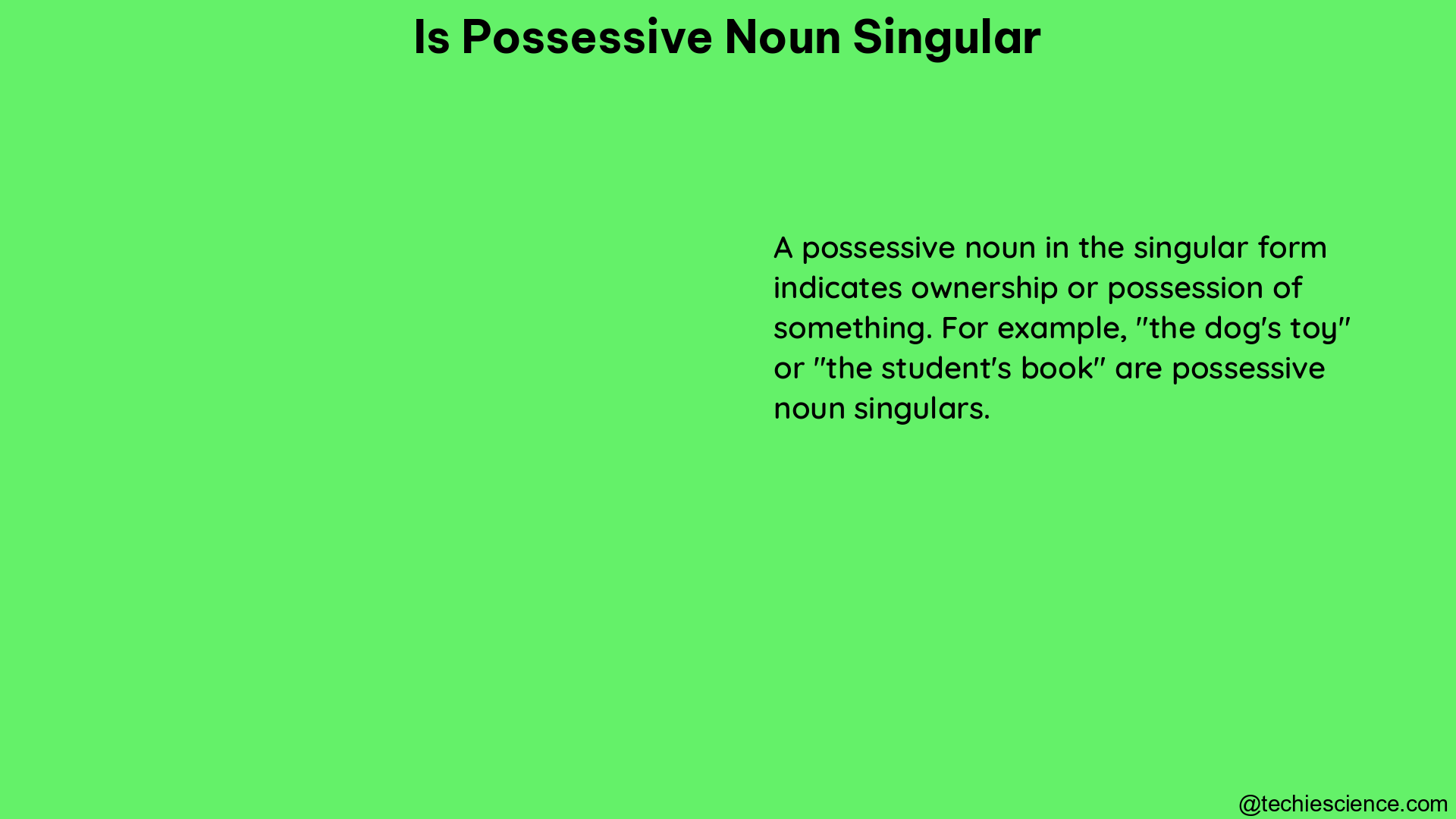A possessive noun is a noun that indicates ownership or possession. In the case of singular nouns, the possessive form is typically created by adding an apostrophe followed by the letter “s” (e.g., “dog” becomes “dog’s”). This rule applies even if the singular noun ends in “s” (e.g., “Sara” becomes “Sara’s”).
Understanding Singular Possessive Nouns
Singular possessive nouns are used to show that a single person, place, or thing owns or has a direct connection to something. This is a fundamental concept in English grammar, and it’s important to understand the rules and nuances surrounding it.
Forming Singular Possessive Nouns
The general rule for forming a singular possessive noun is to add an apostrophe and the letter “s” to the end of the noun. This applies regardless of whether the noun already ends in “s” or not. Here are some examples:
- Dog’s toys: The possessive form of “dog” is “dog’s,” indicating that the toys belong to the dog.
- Sara’s car: The possessive form of “Sara” is “Sara’s,” indicating that the car belongs to Sara.
- The cat’s fur: The possessive form of “cat” is “cat’s,” indicating that the fur belongs to the cat.
- James’s book: The possessive form of “James” is “James’s,” indicating that the book belongs to James.
- The boss’s decision: The possessive form of “boss” is “boss’s,” indicating that the decision belongs to the boss.
It’s important to note that even if a singular noun already ends in “s,” you still add an apostrophe and an additional “s” to form the possessive. This is a common point of confusion, but it’s a crucial rule to remember.
Exceptions to the Rule
While the general rule for forming singular possessive nouns is to add an apostrophe and “s,” there are a few exceptions to this:
-
Proper names ending in “s”: For proper names that already end in “s,” such as “Socrates” or “Jesus,” the possessive form is created by adding only an apostrophe, without an additional “s.” For example, “Socrates’ philosophy” and “Jesus’ teachings.”
-
Ancient proper names: For some ancient proper names, such as “Achilles” or “Moses,” the possessive form is created by adding only an apostrophe, without an additional “s.” For example, “Achilles’ heel” and “Moses’ law.”
-
Pronouns: Possessive pronouns, such as “his,” “her,” “its,” “our,” and “their,” do not use the apostrophe-s construction. Instead, they have their own unique possessive forms.
It’s important to be aware of these exceptions and apply them correctly when forming singular possessive nouns.
Placement of Singular Possessive Nouns
Singular possessive nouns typically come before the object of possession. This means that the possessive noun precedes the noun it is modifying. For example:
- The dog’s toys: The possessive noun “dog’s” comes before the noun “toys,” indicating that the toys belong to the dog.
- Sara’s car: The possessive noun “Sara’s” comes before the noun “car,” indicating that the car belongs to Sara.
- The cat’s fur: The possessive noun “cat’s” comes before the noun “fur,” indicating that the fur belongs to the cat.
This placement of the possessive noun before the object of possession is a standard convention in English grammar and helps to clearly convey the relationship between the two nouns.
Singular Possessive Nouns in Sentences

Singular possessive nouns can be used in a variety of sentence structures to indicate ownership or a direct connection. Here are some examples:
- Subject-Verb-Possessive Noun-Object:
- “The dog’s toys are scattered across the floor.”
- “Sara’s car needs a new tire.”
-
“The cat’s fur is soft and fluffy.”
-
Possessive Noun-Noun:
- “The dog’s bowl is empty.”
- “Sara’s house is on the corner.”
-
“The cat’s paw is injured.”
-
Possessive Noun-Gerund:
- “The dog’s barking woke me up.”
- “Sara’s singing is beautiful.”
-
“The cat’s meowing is annoying.”
-
Possessive Noun-Adjective-Noun:
- “The dog’s new toy is a chew bone.”
- “Sara’s red car is fast.”
- “The cat’s long fur needs brushing.”
In each of these examples, the singular possessive noun clearly indicates the ownership or direct connection between the possessor and the object of possession.
Advanced Concepts in Singular Possessive Nouns
While the basic rules for forming and using singular possessive nouns are straightforward, there are some more advanced concepts and nuances to consider:
Compound Nouns
When dealing with compound nouns (two or more words that function as a single noun), the possessive form is typically added to the end of the entire compound noun. For example:
- The mother-in-law’s house: The possessive form is added to the end of the compound noun “mother-in-law.”
- The attorney general’s decision: The possessive form is added to the end of the compound noun “attorney general.”
- The secretary of state’s visit: The possessive form is added to the end of the compound noun “secretary of state.”
Possessive Nouns with Modifiers
When a singular possessive noun is modified by an adjective or other modifier, the possessive form is still added to the end of the noun, not the modifier. For example:
- The young boy’s toy: The possessive form “boy’s” is added to the end of the noun “boy,” not the adjective “young.”
- The large dog’s bowl: The possessive form “dog’s” is added to the end of the noun “dog,” not the adjective “large.”
- The beautiful woman’s dress: The possessive form “woman’s” is added to the end of the noun “woman,” not the adjective “beautiful.”
Possessive Nouns with Titles
When dealing with titles, the possessive form is typically added to the end of the title, not the person’s name. For example:
- The president’s decision: The possessive form “president’s” is added to the title “president,” not the person’s name.
- The doctor’s office: The possessive form “doctor’s” is added to the title “doctor,” not the person’s name.
- The professor’s lecture: The possessive form “professor’s” is added to the title “professor,” not the person’s name.
Possessive Nouns with Abbreviations
When forming the possessive form of an abbreviation, the apostrophe and “s” are added to the end of the abbreviation, not the full form of the word. For example:
- The U.S.’s policies: The possessive form “U.S.’s” is added to the abbreviation “U.S.,” not the full form “United States.”
- The Ph.D.’s research: The possessive form “Ph.D.’s” is added to the abbreviation “Ph.D.,” not the full form “Doctor of Philosophy.”
- The M.D.’s diagnosis: The possessive form “M.D.’s” is added to the abbreviation “M.D.,” not the full form “Doctor of Medicine.”
Understanding these advanced concepts will help you navigate the nuances of using singular possessive nouns in more complex situations.
Conclusion
Singular possessive nouns are a fundamental aspect of English grammar, and mastering their usage is crucial for effective communication. By understanding the rules for forming singular possessive nouns, recognizing exceptions, and applying them correctly in various sentence structures and advanced scenarios, you can enhance your writing and speaking skills.
Remember, the key to using singular possessive nouns effectively is to consistently add an apostrophe and the letter “s” to the end of the noun, even if it already ends in “s.” With practice and attention to detail, you’ll be able to confidently and accurately use singular possessive nouns in your everyday language.
References:
- Scribbr. (n.d.). Possessive Nouns: Rules, Examples, and Exercises. Retrieved from https://www.scribbr.com/nouns-and-pronouns/possessive-noun/
- Kent State University. (n.d.). Possessive Nouns. Retrieved from https://www-s3-live.kent.edu/s3fs-root/s3fs-public/file/possessive-nouns.pdf?VersionId=uPNfamxuv5ksQyblaln5WVnFACXDU_Zl
- Grammarly. (2020, April 24). Possessive Nouns: Rules, Examples, and Exercises. Retrieved from https://www.grammarly.com/blog/possessive-nouns/
- YouTube. (2015, September 24). Possessive Nouns | English Grammar | iken Edu. Retrieved from https://www.youtube.com/watch?v=NHbc32U9Y4M
- YouTube. (2016, September 13). Possessive Nouns – English Grammar. Retrieved from https://www.youtube.com/watch?v=jUrAmgvy6RU

Hi…. I am Goutam Datta. I have completed a double M. A. in English and B. Ed. I am a creative writer. Currently, I am a part of the LambdaGeeks.